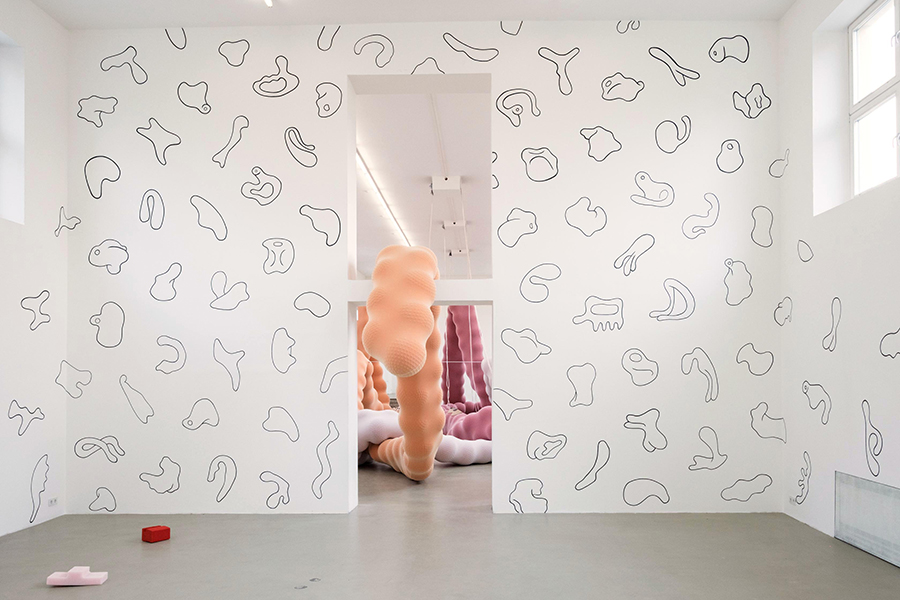Aesthetics and Prosthetics: Artist Eva Fàbregas’s Transhumanist Vision
The London-based sculptor’s new show at Kunstverein München delves into the queasy malleability of bodies
The London-based sculptor’s new show at Kunstverein München delves into the queasy malleability of bodies

If you’ve ever watched Richard Fleischer’s science-fiction film Fantastic Voyage (1966), in which a submarine squad is microscopically shrunk and injected into a wounded scientist, then Eva Fàbregas’s exhibition at Kunstverein München might have a familiar visual resonance. Tasked with fixing the scientist’s brain, the Fantastic Voyage team journey deep inside his body, encountering giant cells that drift abstractly. Likewise, visitors to ‘Those Things that your Fingers Can Tell’ discover large-scale sculptures and wall drawings that evoke enlarged organs. Suggestive of delicate flesh, Fàbregas’s abstract forms are corporeal, while also alluding to tools and instruments that can be used on or with our bodies.
The exhibition’s centrepiece installation, Pumping (all works 2019), comprises three vast, coiled intestinal forms dominating the principal space. They interweave, piled atop each other; one flops over a doorway as a protruding rectum; the others hang upon taut wires as towering structures. Their candy-coloured skins of lilac, magenta and coral fabric have seams like tights, while the large textured balls that fill them half-protrude through the fine material like a myriad nipples.

Fàbregas refers to these works as ‘inflatables’ or ‘instruments for tactile sound’. Wires run into the bulbous colonic forms; catheters attach to subwoofers that double as dermal patches or stethoscopes that deliver heartbeats. The sculpture truly comes to life when the textural sounds of Jamaican electronic music collective Equiknoxx are pumped through speakers. Initially, the work vibrates as a massage chair might, a synth repeating a simple tune that recalls a life-support machine. Then, an alarm sounds amid a melody of impassive xylophone chimes, which breaks into a rhythmic sub-bass dub beat. It’s like listening to a living organism, hearing its complex pulse from the inside. For Fàbregas, we are affective entities implicated by our surroundings and, as such, listening becomes an experience of auditory-tactile synaesthesia – we hear through our fingertips, sense throbbing sound with our bodies – that connects us to each other.
Such somatic awareness traverses the show’s other works. Take, for example, Nancey, a huge beige ear mould exiled from the canal, its curved form and soft textured surface almost erotic, or Kimberly and Chloe, two similarly large and rounded entities penetrating one another. Nearby, Bite Plate is inspired by orthodontic correctors, bright pink matter oozing out of a giant wrinkled plastic trough, spilling onto the ground in creamy pools. This softness and slopping draws upon autonomous sensory meridian response, which uses tactile triggers to stimulate euphoric sensations. The effect, too, is one of calm, a sense of contentment at being near such physically appealing matter. It’s incredibly hard not to touch, prod or even stroke the sculptures.

While fleshy and palpable, they too appear medical, and as such Fàbregas’s sculptures are the stuff of science fiction: by making material objects that relate to humans, which manipulate scale and matter, the artist invokes the idea that we too are flexible forms to be enhanced and engineered to perfection through mechanisation. The wall drawing Polifilia delineates a series of speculative shapes akin to mutating cells. Based on an assortment of devices used for therapeutic, prosthetic, ergonomic and pleasure purposes, it explores how our needs and desires are satisfied by design. Such abstraction potentially conflates anatomy and automation to suggest something new and undefined.
Writing in the 1940s, the filmmaker Sergei Eisenstein devised the term ‘plasmaticity’ to define an intelligent liquid that can be utilized to make future species. Fàbregas’s vision is also one of transhumanism, advocating for a human condition transformed by sophisticated technologies. Our limitations are merely the starting point for attaining a more sensual way of being, one in which relaxation and euphoria are privileged over suffering. For Fàbregas at least, the future is bright.
Eva Fàbregas, ‘Those things that your fingers can tell’ runs at Kunstverein München until 5 May 2019.
Main image: Eva Fàbregas, Shaper, 2019, resin, steel, paint, 95 × 100 × 90 cm. Courtesy: the artist and Kunstverein München























